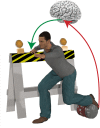Forecast or Fall: Prediction's Importance to Postural Control
- PMID: 30425680
- PMCID: PMC6218399
- DOI: 10.3389/fneur.2018.00924
Forecast or Fall: Prediction's Importance to Postural Control
Abstract
To interact successfully with an uncertain environment, organisms must be able to respond to both unanticipated and anticipated events. For unanticipated events, organisms have evolved stereotyped motor behaviors mapped to the statistical regularities of the environment, which can be trigged by specific sensory stimuli. These "reflexive" responses are more or less hardwired to prevent falls and represent, maybe, the best available solution to maintaining posture given limited available time and information. With the gift of foresight, however, motor behaviors can be tuned or prepared in advance, improving the ability of the organism to compensate for, and interact with, the changing environment. Indeed, foresight's improvement of our interactive capacity occurs through several means, such as better action selection, processing, and conduction delay compensation and by providing a prediction with which to compare our actual behaviors to, thereby facilitating error identification and learning. Here we review the various roles foresight (prediction) plays in maintaining our postural equilibrium. We start by describing some of the more recent findings related to the prediction of instability. Specifically, we cover recent advancements in the understanding of anticipatory postural behaviors that are used broadly to stabilize volitional movement and compensate for impending postural disturbances. We also describe anticipatory changes in the state, or set, of the nervous system that may facilitate anticipatory behaviors. From changes in central set, we briefly discuss prediction of postural instability online before moving into a discussion of how predictive mechanisms, such as internal models, permit us to tune, perhaps our highest level predictive behaviors, namely the priming associated with motor affordances. Lastly, we explore methods best suited to expose the contribution of prediction to postural equilibrium control across a variety of contexts.
Keywords: anticipation; balance; fall; postural control; posture; prediction.
Figures


References
Publication types
LinkOut - more resources
Full Text Sources

